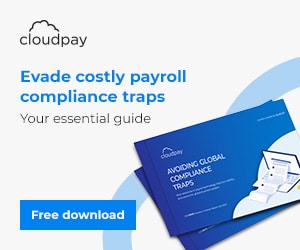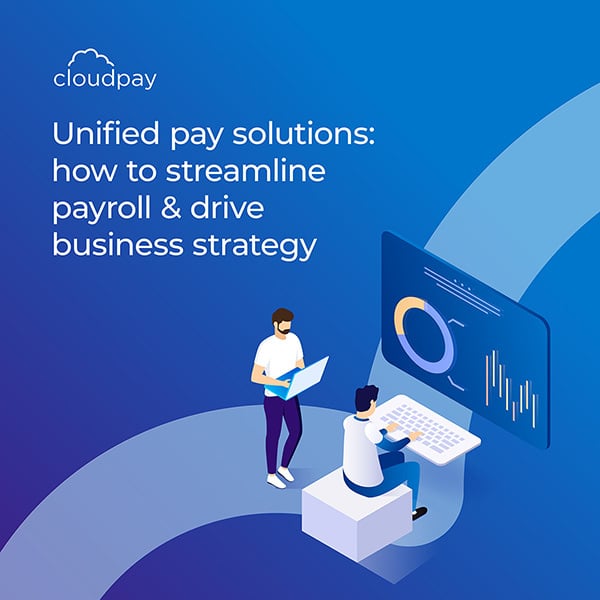Start your RPF process right now by
downloading our free payroll RFP template
Just need a simple reminder?
Try our printable RFP process checklist.
What is a global
payroll RFP?Before you start
your RFP strategyWhat to include in
your Payroll RFP?Deploying the most effective RFP structure
What is a global RFP?
A global payroll RFP (Request for Proposal) is a formal document that an organization prepares and sends to potential global payroll service providers or vendors when seeking to outsource their international payroll processes. This payroll outsourcing proposal outlines the company’s specific payroll needs, requirements, and expectations across multiple countries. This then allows potential payroll providers to submit competitive proposals and bids for providing global payroll services.
For many multinational companies, moving from a decentralized supplier landscape to a truly global payroll solution involves multiple steps. Before a company can implement a new solution and onboard its payroll team, it needs to:
- Build a business case
- Win internal buy-in
- Vet potential suppliers
- Finalize an agreement with its selected service provider.
To successfully navigate these processes, many companies use a tried and tested approach to selecting a new service provider: the request for proposal, or RFP.
What is the difference between RFI, RFQ and RFP?
RFI
Request for Information
A high-level market assessment used to understand which vendors offer what. The response to the RFI will help you create a shortlist of vendors you want to issue the RFP to.
RFQ
Request for Quote
Includes pricing and is used to establish the cost for the product or the service. They can include information like financial status. But ultimately, they’re just asking for a quote.
RFP
Request for Proposal
is a detailed vendor assessment which should ask for information on all sorts of topics including (but not limited to), service and support, governance, data and security, implementation and country-specific requirements.
What are the Benefits of creating an RFP?
A comprehensive RFP can:
By following a few essential best practices, key stakeholders (such as payroll, HR, and Finance teams) at multinational companies can engage in a more strategic approach to RFP creation, deployment, and management. This will ultimately help your company select and implement a global payroll solution that aligns with your broader goals and objectives.
Prefer to start your RFP process right now?
Download our free global payroll RFP template
Before you start your RFP strategy
It’s important to define what you’re trying to achieve before creating your RFP. There’s nothing wrong with reviewing an old RFP as part of your process, but to start there is skipping a step. Beginning with questions to understand current problems, future objectives, and what the company hopes to gain from a new supplier, will lead to a much stronger start for your RFP process.
Taking an end-to-end look at your existing circumstances is an essential part of supplier selection, as is mapping out how a payroll transformation aligns with departmental and company goals. From there, you can craft a smart strategy for your internal RFP management:

Problems
What is not working with your current payroll model?
Your company wouldn’t be pursuing a new solutions provider if you were happy with your current approach to global payroll. To help prioritize the questions and concerns most important to your RFP, map out your existing pain points – large and small – that you’re struggling with now. These could include:
- Managing too many suppliers, resulting in poor visibility and inadequate control over your payrolls
- High rates of re-runs and supplemental runs, leaving you with bloated country or regional costs
- Poor or no integration with HR solutions
- IT challenges (bandwidth, downtime), potentially leading to user experience and functionality issues
- Compliance gaps or lapses, resulting in possible data security issues or concerns
Objectives
What is your payroll team or overall business trying to achieve?
A global payroll transformation isn’t just a change for payroll – it’s a change for your entire company. Payroll touches every employee in a multinational company and interacts with many different departmental functions. It plays a crucial role in enterprise initiatives, such as overseas expansion (or contraction), recruitment and talent management, and cost-cutting.
Consider the objectives for both payroll and the broader business. Are you trying to:
- Decrease payroll errors and costs, by automating more of the payroll cycle?
- Support global or regional expansion into new countries, to eliminate shadow payrolls?
- Lower payroll headcount, by consolidating your payroll into a global shared service?
- Decrease IT bandwidth dedicated to payroll, by shifting all enterprise solutions to the Cloud?
- Integrate with a new ERP or HCM solution?
- Gain a global view of payroll costs and performance by eliminating internal invoicing and enhancing your analytics capabilities?
- Standardize processes across geographies, resulting in enhanced data security and compliance management?
By engaging in more thoughtful, strategic thinking in advance of developing your RFP, you will set your company up for greater success in supplier selection. Armed with a solid understanding of your company’s current issues and future objectives, you can start mapping out your global payroll supplier selection approach, beginning with your internal RFP action plan.

Strategy
What is your internal plan for payroll supplier selection?
Having an internal game plan will make it much easier to manage the process down the line. Questions that will help you craft an internal RFP strategy include:
- What is your target date for having a new solution implemented?
- What countries are in the project scope? Have any been left out of the change project, and why?
- How long will you give suppliers to respond to the RFP?
- Who in your company will be involved in creating the RFP, and who will be reviewing the suppliers’ responses?
- Do you have an existing shortlist of suppliers? Why or why not?
- How will you evaluate the suppliers’ overall submissions?
- Do you have executive buy-in and an approved budget?
Work out your answers to these questions and collect your data more generally. Consider your resources and capacity for the project and set metrics.
Think about how many proposals you want to receive and how much time, thought, and effort should go into the review cycle for a decision as significant and wide-ranging as a global payroll solution change. Even four RFPs are a lot to review. Often one or two suppliers out of four could be eliminated based on information easily accessible beforehand via sales calls, product demonstrations, or virtual or in-person Q&As.
Prefer to start your RFP process right now?
Download our free global payroll RFP template
What to include in your Payroll RFP?
The information you provide in your RFP will dictate how smoothly and efficiently you can move through the supplier selection process. Before moving on to your product- and service-oriented orientated questions, your RFP should include:
Use clear, concise language and provide detailed specifications. The clearer, realistic, and reasonable information you provide, the more likely you are to be pleased with the outcome.
In instances where companies fail to provide the above information – omitting a full statement of work, for example – the more likely that problems may arise as the contract or purchase order is being finalized. At a minimum, your RFP should specify what a company is looking for, and establish the criteria that are going to be used for evaluating the responses.

What questions should you ask in your RFP?
Asking the right questions is the meat of the RFP process. These are the foundation of your entire supplier selection process.
Get the right people involved
There are typically five functions at your company that are directly connected to the execution of global payroll:
- HR
- IT
- Finance
- Operations
- Payroll
With larger companies, that have very targeted departmental functions, there may be many more areas of the business to consider, such as Benefits Administration, Shared Services, and so on.
For each of those functions – as well as each of your global office locations – ask yourself and your payroll-change project team the following:
What are the department’s must-have features and functions?
Do you require…
- System-to-system compatibilities?
- Uptime/support/service coverage needs?
- Technological capabilities and process controls?
What are your nice-to-have features and functions?
For example…
- Automation and efficiency/productivity enhancers?
- Process monitoring and data analytics tools?
- Improved user experiences and integrations?
What is the must-know information for the department regarding a new solution?
Do you need information on…
- Licenses, certifications, and product or service specifications?
- Workflows, oversight, and management processes
- Product roadmap and expected system changes?
What factors would eliminate a supplier?
For example…
- Missing or lacking features, services, or functionalities
- Cost, service model, contract, or liability issues
- Supplier culture or other intangibles
Get specific
The typical RFP is packed with generic questions. Of course, plenty of those generic questions may be important to stakeholders within the buyer’s company; however, often, many are not.
As you have assessed your company’s needs, goals, scope, and budget, and crafted an internal RFP strategy, ideally, you should also define the holistic priorities of your global payroll change project. As you develop the RFP document(s), you should drill down even further into what matters most to the various departments and stakeholders.

Armed with the above information, you can determine which needs, wants, and concerns take priority over others. Prioritize each topic by placing high-priority questions higher up, and by weighting responses according to business-wide priority in your scoring system.
You can also use this information to trim generic, filler questions out of your RFP entirely. Whether you decide to revise a modifiable template like this one from CloudPay, or create a new one from scratch, you should ensure every question aligns with a specific piece of information you need to know.


Once you have your needs appropriately identified and prioritized, you’ll need to pose and present your questions to help you receive the most useful, applicable, and insightful responses possible.
Fi Marcham, Bid Writer at CloudPay
Expert tips on crafting your RFP questions
Once you have your needs appropriately identified and prioritized, you’ll need to pose and present your questions to help you receive the most useful, applicable, and insightful responses possible.
A more standard global payroll RFP might phrase a question the following way:
“Describe your process for post payroll verification.”
Asking a more specific question will result in a more helpful answer. For example:
“Will you notify our payroll approvers when approvals are needed? If so, how?”.
Instead of posing your question in a basic and general way, such as:
“What reporting and analytics capabilities do you offer?”
Follow the first question with the question below, and you’ll get answers that will truly differentiate them from other service providers:
“Can users create custom reports? How? Is there a cost?”
Prefer to start your RFP process right now?
Download our free global payroll RFP template
Deploying the most effective RFP structure
Once you have written your questions and organized them in terms of priority, it’s on to the final stage before circulation: structuring your RFP thoughtfully and providing all the appropriate information.
Whether your company’s preference is to use a Word document, an Excel file, or an online tool, the following best practices are essential:
Prefer to start your RFP process right now?
Download our free global payroll RFP template
What benefits should you look for from a provider?
To earn the highest ROI from your RFP process, we recommend soliciting (and selecting) a global payroll managed services provider that can deliver all of the following system benefits, in addition to reliable managed services and always-on support:
Process Optimization
Spot and eliminate gaps, inefficiencies, or weaknesses in your workflow and/or compliance measures
Workflow Automation
Establish pre-set processes and timelines that automate as much of end-to-end payroll as possible
Global Standardization
Create global processes across all geographies you serve, with custom steps for country requirements
Modern Interface
Employ an attractive, easy-to-navigate system across your entire payroll function
System Integration
Seamlessly import and/or transfer data from HR and Finance systems into your payroll technology
Data Integrity
Catch errors automatically through pre- and post-process checks on all information in your payroll system
Digital Calendars
Monitor progress across all payrolls using a cloud-based calendar linked to your global workflow
Compliance Tracking
Maintain global compliance and track potential issues and resolutions in real-time
Analytics
Access a dashboard view of payroll performance at the global, regional, country, or payroll level
When undertaking a global payroll transformation, you need a partner that truly understands the complexities and nuances involved. CloudPay provides deep expertise and comprehensive global payroll solution.
As a managed services provider, CloudPay offers a unified platform that streamlines and automates your entire payroll process across countries. Our solution ensures process optimization, workflow automation, global standardization, and seamless integration with your existing HR and finance systems. You gain a modern interface, robust data integrity checks, digital payroll calendars, real-time compliance tracking, and powerful analytics dashboards – all essential elements for effective global payroll management.
CloudPay’s extensive global footprint, combined with our network of local partners, provides you with the local expertise and compliance assurance you need in each country. Our technology is designed to handle complexities like multi-currency processing, language support, and data privacy regulations like GDPR. Whether you’re expanding into new regions or consolidating payroll operations, CloudPay’s scalable and flexible solution can adapt to your evolving business needs.
We’ve helped hundreds of businesses with their payroll transformation and can provide trusted, expert advice. Get in touch to take the next step.
Payroll
Our managed Payroll solution, delivered by our experts via our market-leading platform, gives you global unity and visibility.
Pay On-Demand
Our global Pay On-Demand solution gives your employees access to the wages they’ve earned, when they need them.
Platform
Our platform provides standardized data and visibility to manage all your global pay services in a single ecosystem
CloudPay NOW App
Our app gives your staff instant access to earned income for our Pay On-Demand solution, plus a range of wellbeing content.
Start your RFP process right now by
downloading our free payroll RFP template






